Home / Arts / Advertising / Cinderella / Dance / Fabergé / Giselle / Imagery / Iconography / Lalique / Marmite / Theatre / Tribute
History of the Ballet
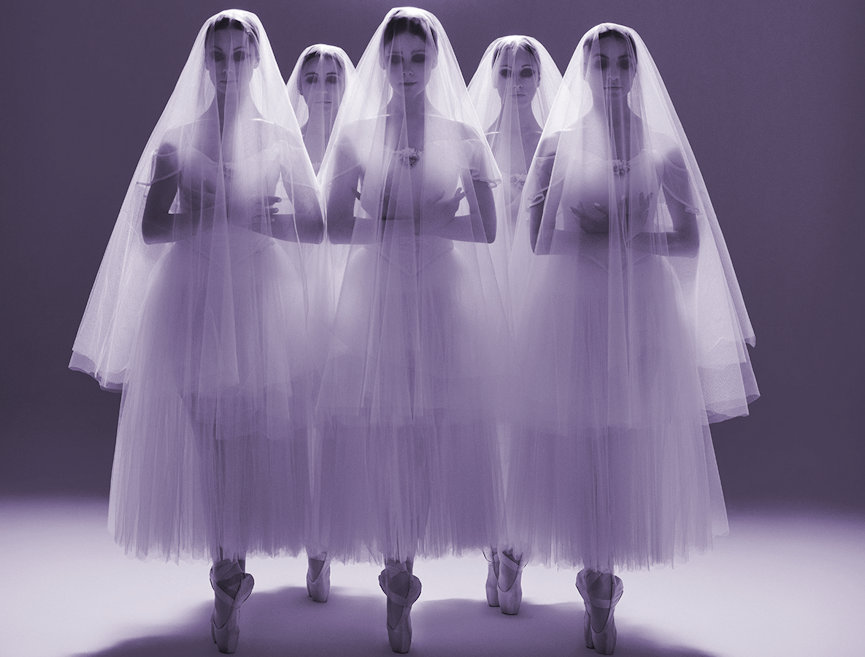
Image courtesy & © of the Dutch National Ballet
Composer - Adolphe Adam (1803-1856)
 Adolphe Adam (1803–56) was one of the most prolific composers for the Paris stages. He was innovative in the emotional connection he introduced between his music and events of stage. Today he is best remembered for his ballet scores Le Corsaire and Giselle.
Adolphe Adam (1803–56) was one of the most prolific composers for the Paris stages. He was innovative in the emotional connection he introduced between his music and events of stage. Today he is best remembered for his ballet scores Le Corsaire and Giselle.
Adam was born in Paris. His father, a pianist and composer, did not encourage his son to follow him into music, but from an early age Adam determined to compose for the theatre. He entered the Paris Conservatoire aged 17 and studied organ, counterpoint and composition. Adam met the librettist Eugène Scribe on tour in Geneva in 1826 and soon afterwards collaborated with him on a number of comic operas, including the hugely successful Le Chalet (1834). Adam made his debut at the Opéra-Comique with Pierre et Catherine (1829). After the 1830 July Revolution he moved to London, where his works included His First Campaign. Adam returned to Paris permanently in 1833 and made his Paris Opéra debut with the ballet La Fille du Danube (1836) for Marie Taglioni. His ballet Giselle (1841) for the Opéra, allegedly composed in three weeks, is his most enduring work.
In 1847 Adam opened a new Paris opera house, the Opéra-National. It was forced to close after the 1849 revolution, leaving Adam ruined. He created his last great ballet, Le Corsaire, in 1856. Prolific to the end of his life, he died in his sleep four days after the premiere of Les Pantins de Violette. Source : ROH
Adolphe Adam was born in Paris July 24, 1803 as the son of a music professor at the Conservatoire. His mother the daughter of a notable physician. As a child, he preferred to improvise music of his own rather than study music seriously.
Adam began musical studies at boarding school and entered the Conservatoire in 1821, studying organ and harmonium under Benoist and later Boieldieu. His father did not encourage him to pursue a musical career. Rather it was his friendship with one of his father‘s students, Ferdinand Herold (who is best known today as the composer of La Fille mal gardée), that influenced Adolphe to want to be a composer, specifically for the theatre. Boieldieu also encouraged him at this pursuit. By age 20 Adam was writing songs for Parisian vaudeville houses and was playing in the orchestra at the Gymnase, where he would later become chorus master. In 1825 Adam helped Boieldieu with the preparation of his opera "La Dame blanche", which he also transcribed to piano for popular sale. With money he made from this enterprise Adam travelled to Belgium, Holland, Germany and Switzerland. In Geneva he met Eugene Scribe with whom he would collaborate on numerous operas over the coming 30 years.
By 1830 Adam had completed 28 theatre works including some dances. His first dramatic composition was a one act operetta, Pierre et Catherine that was performed at the Opera Comique in 1829, and went on for another 80 performances. His first 3 act opera, Danilowa, came in 1830, but performances were interrupted by the Revolution. Adam returned to his vaudeville activities and co-wrote his first ballet, La Chatte Blanche, with Casmir Gide the same year.
Adam‘s first solo ballet composition was Faust in1833 for choreographer Andre Deshayes at the King‘s Theatre in London. His first work for the Paris Opera was the music for the ballet "La Fille du Danube" for Taglioni in 1836. He travelled to St. Petersburg to present the same work, a new ballet, L‘ecumeur de mer, and an opera for the court of Tsar Nicholas I. Adam‘s next important work was the music for the ballet "Giselle", for which he is probably best known today. It premiered at the Paris Opera June 28, 1841. Shortly after the successful "Giselle", a new director was in place at the Opera with whom Adam had serious quarrels. It was made known that a work of his would never again be performed at the theatre. Adam invested his own money and borrowed heavily to open a third opera house of his own. In 1847 Adam opened the Theatre National, in Paris, as a showcase for young composers. Due to the Revolution it had to be closed the following year, leaving Adam in huge debt. Assigning all his royalties to pay off the debt, he turned to journalism to earn some money. In 1849 Adam became Professor of Composition at the Conservatoire, a position he held until his death. All the while he continued his compositions, among others his ballet "Le Corsaire" premiered January 1856. Eventually, through hard work, he paid off all the debts but at the cost of his own health.
Adolphe Adam died May 3, 1856 in Paris having written 40 operas, 14 ballets and numerous light operas and vaudevilles. Source : Opera and Ballet.com
Author(s) - Théophile Gautier, Chevalier de St. Georges, and Jean Coralli
Attributed in the main to Théophile Gautier by the Opéra Nationale in Paris
Giselle - A Ballet in two acts (1841)
The Story (Synopses)
Act I: The ballet is set in the vineyard country bordering the Rhine. Hilarion, the village huntsman and a gamekeeper to the court, returns from his early morning chores and pauses before a neighboring cottage—the home of Giselle, with whom he is in love. Villagers pass by on their way to the vineyards, where they will harvest the last of the grapes before the Wine Festival.
Count Albrecht arrives with his squire and enters a cottage opposite Giselle’s. He emerges dressed as a peasant, submits his disguise to the squire’s inspection, and dismisses him. Hilarion has witnessed this exchange and is puzzled that the squire should show such deference to this youth, who is known to the villager as a fellow peasant named Loys. Loys excuses himself from joining the grape pickers so that he can be alone with Giselle. He swears eternal love, and she takes the traditional test with a daisy—“he loves me, he loves me not.” When it appears the answer will be “not,” she throws the flower away; Loys retrieves it and, by surreptitiously discarding a petal, comes up with the answer “he loves me.” Hilarion interrupts, protesting that he, and not Loys, truly loves Giselle. A quarrel ensues, and Hilarion’s suspicions deepen as Loys instinctively reaches for the sword that, as a nobleman, he is accustomed to wearing.
The villagers return, and Giselle invites them to join in a dance to celebrate the harvest. Her mother, Berthe, interrupts and warns her that her life may be endangered if she overexerts herself by dancing. She is struck by a momentary hallucination of her daughter in death. She sees her as a Willi, a restless spirit who has died with her love unrequited.
A horn sounds in the distance, and Loys recognizes it as coming from the hunting party of the prince of Courland. As Loys hastily departs, Hilarion breaks into Loys’ cottage. Refreshments are served to the hunters, and the prince’s daughter, Bathilde, gives Giselle a gold necklace when she learns they are both engaged to be married. After the royal party has returned to the hunt, Hilarion emerges from Loys’ cottage with a hunting horn and a sword, further evidence that the supposed peasant is, in fact, a nobleman.
The villagers return and proclaim Giselle the queen of the Wine Festival. Hilarion interrupts to denounce Loys as an impostor. When Loys denies the charges and threatens the gamekeeper with his sword, Hilarion blows the hunting horn, a signal for the prince to return. Loys is exposed as an impostor when Bathilde reveals that he is her fiancé, Count Albrecht. The shock of learning of Albrecht’s duplicity is too great for Giselle’s frail constitution. Her mind becomes unhinged, and she dies of a broken heart—her love unrequited.
ACT II: The scene is laid in a clearing in the forest near Giselle’s grave. The Willis are summoned by their queen, Myrta, to attend the ceremonies that will initiate Giselle into their sisterhood. Their love unrequited, they can find no rest. Their spirits are forever destined to roam the earth from midnight to dawn, vengefully trapping any male who enters their domain and forcing him to dance to his death. Hilarion, in search of Giselle, meets his death at their hands. Albrecht arrives to leave flowers on Giselle’s grave. He too is trapped and commanded to dance until death. Giselle resolves to protect him. She dances with him until the clock strikes four, at which hour the Willis lose their power. Albrecht is rescued from death. Source : © Copyright 2003-2007 Ballet Theatre Foundation, Inc. All rights reserved.
Act I
A small, peaceful village, bathed in sunlight. It is inhabited by simple, artless people. Giselle, a young peasant girl, is rejoicing in the sun, the blue sky, the singing of the birds and, most of all, in the happiness of pure, trusting love which has lit up her life. She is in love and is confident that she is loved. The gamekeeper, who is in love with Giselle, tries in vain to persuade her that Albrecht, her loved one, is not a peasant at all but a nobleman in disguise and that he is deceiving her.
The gamekeeper manages to steal into the cottage which Albrecht is renting in the village and here he finds a silver sword with a coat of arms on it. Now the gamekeeper knows for sure that Albrecht is concealing his noble origins.
A party of distinguished noblemen, attended by a sumptuous suite, seek rest and refreshment in the village after the hunt. The peasants give their guests a cordial welcome.
Albrecht is embarrassed by this unexpected meeting: he tries to hide the fact he knows them for, in their company, is his betrothed, Bathilde. Meanwhile the gamekeeper shows everyone Albrecht’s sword and, unmasking him, tells them of the latter’s deceit. Giselle is shocked to the core by the perfidy of her loved one. The pure, crystal-clear world of her faith, hopes and dreams has been destroyed. She goes mad and dies.
Act II
Night-time. The ghostly forms of the Willis, died brides, appear among the graves of the village church yard which is bathed in moonlight. “Dressed in bridal gowns and garlands of flowers ... The irresistibly beautiful Willis danced to the light of the moon. And as they felt the time given them for dancing was running out and that they had again to return to their icy graves, their dancing became more and more impassioned and rapid ...” (Heinrich Heine).
The Willis catch sight of the gamekeeper who, suffering from pangs of conscience, has come to visit Giselle’s grave. At the command of Myrtha, the unrelenting Queen of the Willis, the Willis encircle the gamekeeper and make him dance until he drops lifeless, to the ground.
Albrecht too, is unable to forget Giselle. And, at dead of night, he comes to her grave. The Willis immediately encircle the youth. Albrecht is now threatened by the same horrifying fate as the gamekeeper. But the shadow of Giselle now appears and her eternal and self-sacrificing love protects and saves Albrecht from the anger of the Willis.
The ghostly, white forms of the Willis vanish with the first rays of the rising sun. And Giselle’s ethereal shadow vanishes too, but Giselle will always be alive in Albrecht’s memory — the ever-present regret for a lost love, a love that is stronger than death. Source : The Bolshoi Ballet
The Willis
What are The Willis in the ballet Giselle?
From the ballet "Giselle", the Willis are the ghosts of women dressed in white gowns. They are the young virgins who died before their wedding day. They can be seen as the evil female spirits in the ballet play. They are led by Martha (Myrtha) who is the queen of the Willis. And Giselle is among them as seen in Act 2. Source : Raellarina
The First Giselle
Was Carla Grisi the first Giselle?
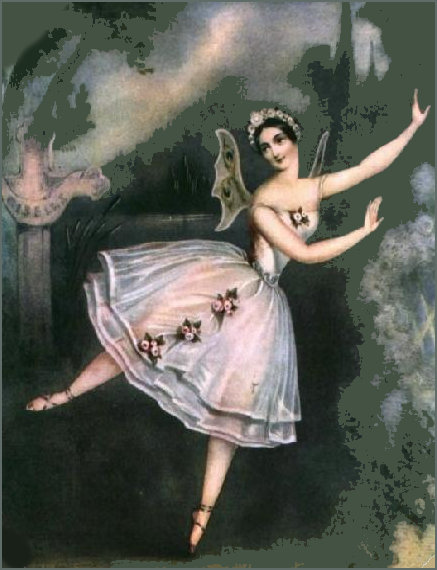
Image source : findagrave.com
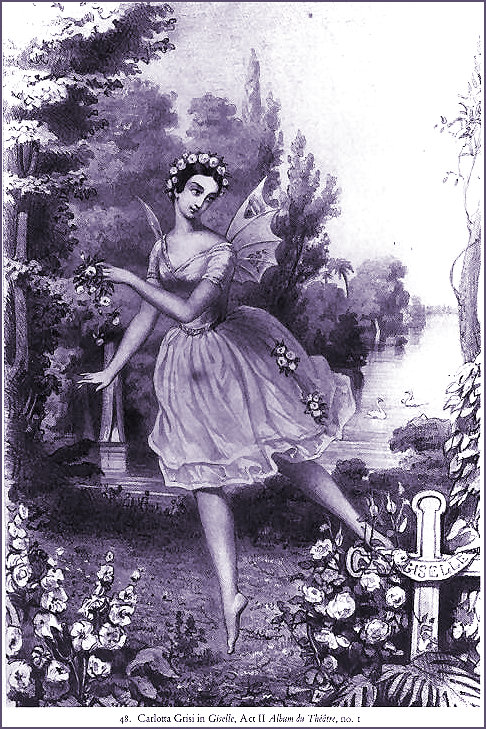
Image source : Giselle (1841) - L'apothéose du ballet romantique
Certainly there is an excellent site dedicated purely to this dancer, who was not only billed as a 'Ballerina' but also also as a 'Court Dancer' so presumably received some sort of royal patronage following her relatively humble beginnings "Carlotta Grisi, whose real name was Caronne Adele Giuseppina Maria Grisi, was born in Visinada, Istria (Croatia), on June 28, 1819. Her mother's name was Maria (born Boschetti), and her father was Vincenzo Grisi, who came to Istria from Cremona to work for the public surveyor's department." Source : istrianet who go on to describe Grisi's tempestuous private and love life and explain her involvement with the ballet "Her Paris debut came at the Théâte de la Renaissance in 1840, where she sang and danced in Le Zingaro. The intervention of Grisi's family led to her engagement at the Paris Opéra in 1841 where she had her professional debut in Donizetti's La favorita which Perot choreographed. Shortly after that came Giselle, a ballet created in Paris long before other famous ballets such as Swan Lake). Giselle was expressly designed to be a showcase for the talents of this young ballerina.
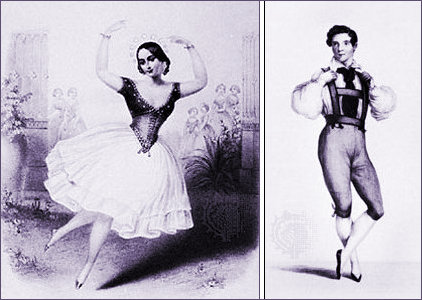
Grisi and her lover/husband Jules Perrot (in 1837, she gave birth to Jules Perrot's daughter, Marie-Julie, the first of two which she bore out of wedlock) performing as Giselle and Albrecht - image & text source istrianet.org
The ballet's creators were all French: the music was composed by Adolphe Charles Adam (1803-56); the scenario by drama critic and poet Théophile Gautier (1811-72) in collaboration with the dramatist Vernoy de Saint-Georges (adapting an old legend in Heinrich Heinene's 1835 work De l'Allemagne which was based on the German legend of the Willis); and the choreographers Jules Perrot in collaboration with the ballet master of the Paris Opera, Jean Coralli Perecini (1779-1854) who is usually referred to as Coralli and born in Paris of Bolognese parents. The scenery was by Pierre Ciceri and costumes by Paul Lormier. [History and background notes on Giselle.]"
Read more here
Giselle Iconography
Giselle was first performed at the Salle Le Peletier in Paris on Sunday 28 June 1841. The choreographers of the production were Jean Coralli and Jules Perrot. On the stage of the Paris Opera Ballet "Giselle" stood at 18,150 performances (compared to the previously most famous ballet "La Sylphide" - was presented 59 times in 12 years. In Russia Giselle was first performed at the Bolshoi Theatre, St. Petersburg, on 18 December 1842. In the 1880s, Ballet Master Marius Petipa made many changes to the Perrot production. His Version became basis for most of modern-days Giselle performances. Giselle, or The Willis survived for more than a century without any significant changes since Marius Petipa’s times and nowadays is being staged all over the world. Source russianbroadway.com
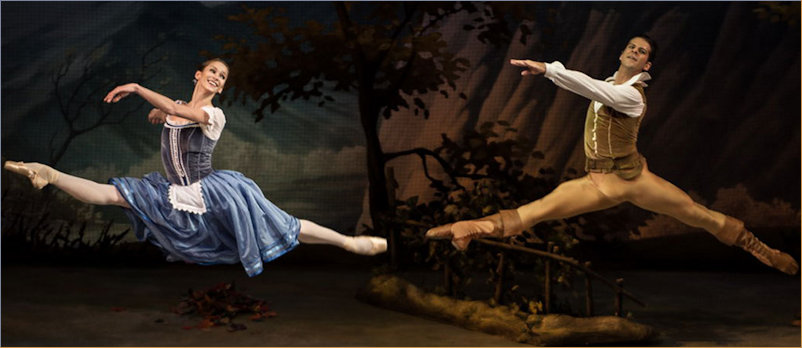
The sheer joy of Giselle and Albrecht at the start of their love affair - image source russianbroadway.com
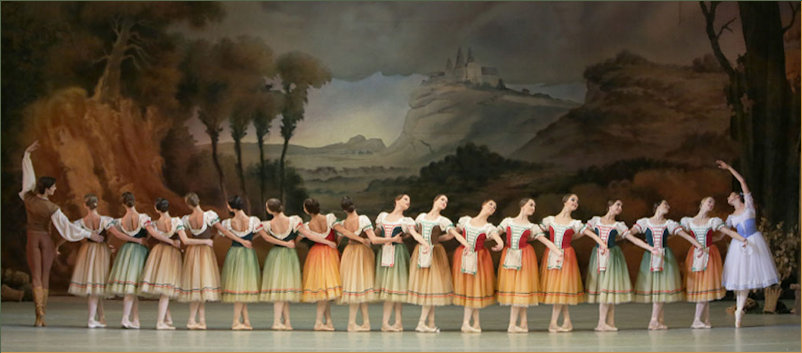
The Village Girls Corps de Ballet - colourful and splendid - image source russianbroadway.com

The first appearance of the Willis in such a familiar pose - image source : Artists of Houston Ballet
Photographer: Amitava Sarkar via the peoplescritic
What a Style difference a century makes!
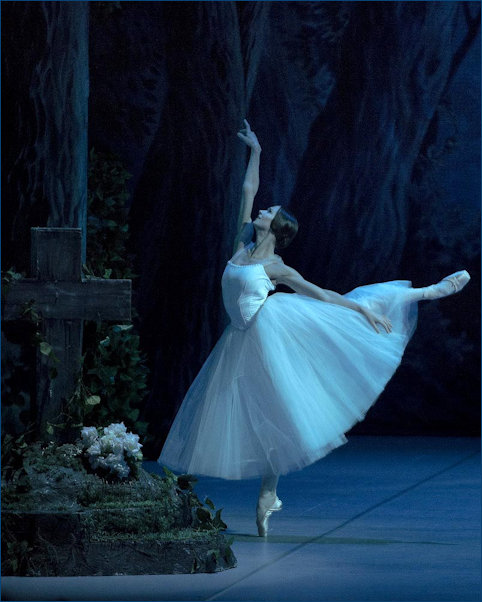
The Mikhailovsky Theatre’s the 2008 production of Giselle - image source mikhailovsky.ru
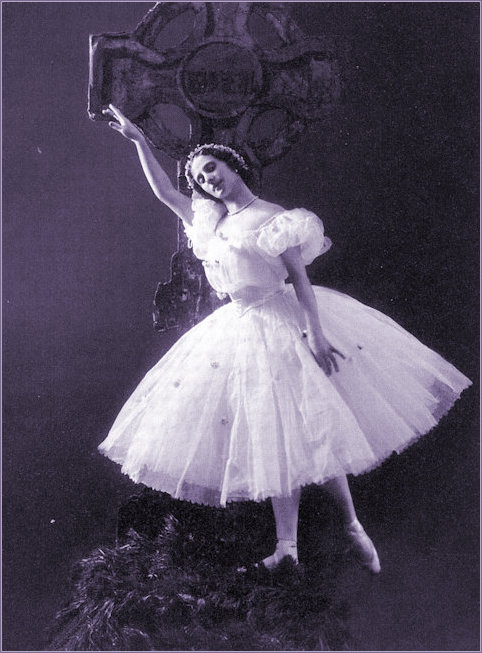
Pavlova as Giselle circa 1910 - image source Pininterest
Giselle at the Dubai Opera
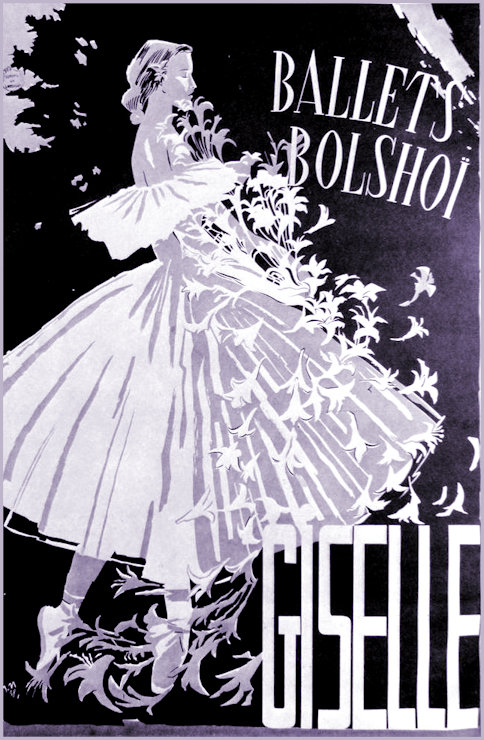
I couldn't resist this piece of artwork for a poster in 2016 - to me it looks 1950s and more of a fashion show style than anything to do with the hauntingly desperately sad tale of 'Giselle'
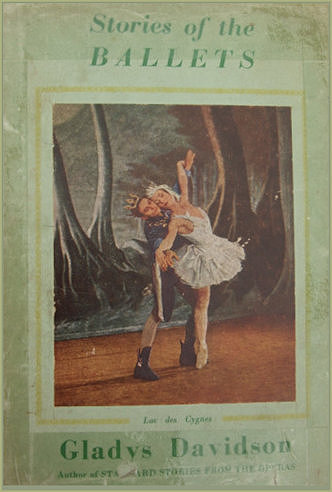
This summary was written by Gladys David son, and published in her book Stories of the Ballets (Werner, Laurie; London 1949).
In the quaint villages snuggling amidst the romantic forest and mountain regions of the Rhine land, many strange, mystic legends of fairies and ghostly visitants were once firmly believed in by the simple peasants who dwelt therein. Even at the beginning of the nineteenth century, these country folk carefully kept away from any lonely spots said to be haunted by such uncanny beings - especially so after darkness had fallen. One of the most curious of these strange legends concerned that of the Willis who were said to reveal themselves in many a forest glade from midnight until four o'clock in the morning. The Willis were believed to be the ghostly sylph-like spirits of young maidens who had been deserted or deceived by their lovers and had died of grief before their wedding bells had chimed - and, in particular, of girls who had had a great love of dancing in their former lives. The Willis spent most of their hours as sylphs in dancing together in a maze of wonderful formations, their ethereal figures in filmy draperies weaving endless patterns as they floated over the flower-starred emerald grass.
But, lovely though they were to look at, the Willis kept up a dangerous grudge against all the male mortals they came in contact with. If any young man happened to be out alone in the forest late at night and was unlucky enough to fall in with a group of Willis dancing as sylphs in the moonlight, he was never seen alive again. The dancing phantoms would quickly surround him and compel him to join in their giddy whirling movements until he became too exhausted to recover and, at last, fell to the ground, dead. Consequently, at the time when the story opens, in the early part of the nineteenth century, it was no wonder that most of the young men in one of these pretty Rhineland villages were still unwilling to find themselves out after midnight in forest glades said to be haunted by the Willis. Even the girls were often warned by their parents to be careful to avoid such danger spots - especially if they happened to be unusually fond of dancing. It was believed in this village that girls with a passion for dancing were more brokenhearted, than those who did not care whether they danced or not.
One of the girls most frequently warned about this was a fair young maiden named Giselle, who, besides being the best dancer, was also the prettiest girl in the village. So beautiful indeed, was this young peasant maiden, Giselle, that she already had two sweethearts. One of these was Hilarion, a forest-ranger or game-keeper, who had loved her deeply for a long time and was hoping to become betrothed to her in due course. Of late, however, he had felt that Giselle was no longer interested in him, as was formerly the case, and that he had a rival. This was the truth. The beautiful Giselle had recently attracted the attention and admiration of Albrecht, the handsome young Duke of Silesia, whose Castle overlooked the village; and he soon fell desperately in love with her. But there were more difficulties in the way of his romance. In the first place, he was already betrothed to the proud Princess Bathilde of Courland, whom he was expected to marry at some not too distant date. Secondly, he was aware that his high social position would not permit of his marriage with a peasant maid. Nevertheless, he had conceived so deep a passion for the beautiful Giselle that he was determined to see her as frequently as possible; and he hoped to win her love. Suspecting that the simple village beauty might be unwilling to meet him as the powerful Duke of that district, and also wishing to keep his sweet romance a secret for the time being, he devised a plan of action with the help of his favourite attendant, a young squire named Wilfred. He made use of an empty cottage which stood opposite the rustic home of Giselle and her mother, Berthe. Here he would arrive secretly and discard his fine clothes as a young lord; and then he would issue forth from the cottage dressed in the simple grab of a peasant. Thus disguised, he made the acquaintance of Giselle, to whom he introduced himself as Loys, a rustic youth.
So charming was the newcomer that Giselle all too quickly fell in love with him; and she believed the handsome Loys to be indeed a peasant such as Hilarion and her other village friends. The lovers met many times, and their ecstatic happiness increased with every meeting. Giselle danced now more than ever before, and was overjoyed on discovering that her beloved Loys was likewise a splendid dancer. He was infinitely more graceful than any of the village youths who had formerly been her partners. Buy Hilarion, the game-keeper, was far from happy. He became furiously jealous whenever he saw Giselle in the company of the stranger, Loys. He also nursed dark suspicions of the latter, not knowing whence he came nor why he had appeared so unexpectedly in the village. Full of mistrust, he determined to keep a close watch upon the hated newcomer who had so quickly stolen away from him the heart of the village belle. He believed him to be a masquerader. Another person likewise uneasy in his mind was the squire attendant, Wilfred, who felt that the young Duke's secret romance could not long remain hidden and that it might end disastrously. One morning, therefore, the anxious Wilfred endeavoured to persuade Albrecht to abandon his dangerous deception; but the latter refused to listen to his wise counsel and angrily ordered him to return to the Castle and attend to certain urgent matters there. And Wilfred perforce had to obey; but he departed with a heavy heart, full of foreboding. Then Albrecht waited for Giselle to come forth from her cottage home; and when the fair maiden presently appeared the happy lovers talked and danced together, full of ecstasy. Meanwhile, Hilarion, who had been lurking in the background and watching them, could restrain himself no longer; and gull of jealous envy at the sight of the happy lovers, he now rushed forth and boldly denounced the stranger Loys as an unknown adventurer not to be trusted. Then he retreated his former sweetheart to have nothing to do with the newcomer, but to accept his own deep and long-lasting love instead. But Giselle had already given her heart to the handsome stranger and had eyes for no one else; and when Hilarion presently began roughly to upbraid her in his own jealous disappointment, the pretended Loys attacked him instantly and soon drove him back to the forest paths. The disguised Duke then returned to his beloved one, and the lovers were joyful together once more.
Presently, the happy pair were joined by a lively group of village lads and maidens carrying baskets of grapes - for it was the vintage season; and the whole party, quickly realising how matters stood between the newcomer and their own lovely Queen of the Village, rejoiced with them, dancing and singing in the most hilarious manner. Presently, Berthe, the somewhat severe mother of Giselle, disturbed by the noise, came forth from her cottage to see what was afoot and to chide the young people for their over-exuberance. Like Hilarion, she did not approve of the handsome stranger who had so recently and unaccountably appeared in their midst; and she now commanded Giselle to return to her home and to her neglected work. She scolded her roundly for thus wasting her time - even declaring warningly that the young girl might presently be transformed into a Willi, if she continued to dance so frequently - and extravagantly. The merry party thus broke up and departed; and Albrecht, satisfied that his disguise as Loys the peasant was still a safe one, wandered off into the woodlands, hoping to see his beloved Giselle again later on. Very soon afterwards, the sound of hunting-horns was heard; and presently a formal hunting-party arrived upon the scene, headed by the Prince of Courland and his daughter, the Princess Bathilde. Among the party was the Duke's squire, Wilfred, who appeared anxious and troubled because his young master had not returned to the Castle in time to receive these important visitors and to join in their sport. To conceal his anxiety somewhat, Wilfred arranged for some light refreshment to be brought out from Berthe's cottage for the enjoyment of the Princess and her royal father. This was set out upon a rustic table; and the high-born visitors condescendingly sat down to refresh themselves. When Giselle presently appeared, curtseying shyly, the great lady talked to her with pleasant interest- totally unaware that the somewhat awed maiden was her rival in the affections of the young Duke, her betrothed; and presently, she graciously slipped her own jewelled necklace around the neck of the pretty peasant girl, to the latter's great delight. The aristocratic guests now accepted Berthe's respectful invitation to rest a short time in her humble abode; and when they had retired into the cottage and the huntsman had strolled off into the forest, Giselle returned alone to look for her beloved Loys. She soon saw him approaching eagerly towards her; and the reunited lovers once more danced with the youthful peasants, who had likewise returned.
But tragedy was already in their midst. The jealous and suspicious Hilarion had, meanwhile, found an opportunity for making his way, unobserved, into the stranger youth's cottage; and he now rushed forth therefrom in a furious rage, and stopped the dancing. He then flung down before Giselle and her lover the latter's rich garments as a Duke, together with his bejewelled sword, declaring that he had found these suspicious objects in the cottage of the stranger, proving that the latter was no peasant but a nobleman of high degree. Next, he blew a loud blast upon a hunting-horn, which quickly brought back the strolling huntsmen, and likewise caused the Prince of Courland and his daughter to come forth from the cottage in haste. Thus the young Duke's masquerade came to end, since he was instantly recognised by the amazed Bathilde and all the royal party as her betrothed, despite the peasant garb he was wearing; and an angry scene followed. But soon anger changed to dismay. The beautiful Giselle was so overcome by grief and shame as she realised her deception by the young Duke and now learned also that the Princess Bathilde was, in truth, his betrothed future wife, that she snatched the jewelled chain from her neck and flung it away as she sank to the ground in a paroxysm of sobs. Then, before the now remorseful Albrecht could reach her side, she sprang up once more and began to fling herself about and to dash hither and thither in a dance of such utter madness that the alarmed company quickly realised that the terrible shock she had received had disturbed the balance of her mind and that she had, indeed, lost her reason. As though living in the recent past, she enacted some of the scenes of her tragic deception - to the frantic grief of Albrecht, who vainly implored her forgiveness and endeavoured to calm her. But the distraught girl broke away from his restraining arms almost in horror; and snatching up his sword she plunged the point of it into her breast. Then, with her last remaining strength, she continued her wild dance. Nobody could stop her uncontrolled but beautifully rhythmic movements; and all the sympathetic spectators could do was to gaze upon the distracted girl in awe-struck horror - in particular, her once severe but now unhappy mother, Berthe, who wrung her hands in the deepest distress, but was powerless to prevent the sad fate she had only so recently predicted for her beautiful and beloved daughter. Then came the tragic climax. Even as the horror-struck company gazed upon the madly-whirling girl, Giselle suddenly stopped and wavered uncertainly for a moment or two; then, uttering a soft sigh, she fell back, dead, into the arms of her weeping mother.
* * * * *
A short time after this sad tragedy, another hunting party was in progress one moonlit night; and the huntsmen, led by the game-keeper, Hilarion, were so eager about their sport that they lingered in the forest much later than usual and lost their way. Presently, they all trooped into a deep mysterious glade, at one side of which stood a newly-made grave on a little mound in a sheltered spot. A small cross had been placed at the head of the grave; and upon this holy symbol appeared the one word, "Giselle." The huntsmen, however, did not notice the newly made grave of the unhappy Giselle; but feeling that this was a somewhat eerie spot into which they had wandered, they began to shiver slightly. Their uneasiness increased presently when Hilarion informed them that this part of the forest was believed to be haunted by those strange unearthly beings, the Wills - those dangerously transformed maidens who had been unlucky in love and had died before their wedding-days had dawned, and who were doomed by a magic enchantment to lure mortal young men to a last fatal dance with them.
The huntsmen were now thoroughly alarmed, for midnight was fast approaching, the hour when the Willis were due to appear; and, in haste, they hurried away, followed by Hilarion, all hoping to escape in time. Scarcely had the young men departed than the chimes of midnight sounded faintly from the distant village; and instantly, the haunted glade became filled with the floating ethereal sylph-like forms of the Wills, gliding in noiselessly from every side like will-o'-the-wisps.
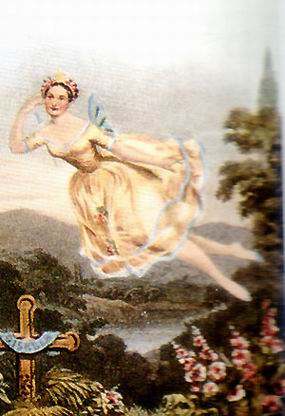 They were led by Myrta, Queen of the Willis, who bade them follow her to the newly-made grave of the beautiful Giselle, their new companion, whom she now proceeded to call forth, waving her magic wand as she did so. Almost immediately, the ghostly form of Giselle appeared in their midst - an airy-fairy sprite now clad in misty, filmy draperies and having small white wings between her shoulders. She was already a Willi; and she felt light as air as she joined her newly-found sister-Willis in their wonderful dances. They were all fated to dance continuously until four o'clock, when they would vanish once more, until midnight came again. As the Wills presently danced away down the glade, the young Duke Albrecht came into it from the other side, attended by his faithful squire, Wilfred. He was now very contrite and sorrowful, for he had truly loved the gentle Giselle, and was full of sincere remorse for having been the cause of her tragic end. Having learned that her simple grave was in this forest glade, he had now come to lay a wreath of lilies at the foot of the little white cross. He had also lost his way, and so had arrived thus late in the glade.
They were led by Myrta, Queen of the Willis, who bade them follow her to the newly-made grave of the beautiful Giselle, their new companion, whom she now proceeded to call forth, waving her magic wand as she did so. Almost immediately, the ghostly form of Giselle appeared in their midst - an airy-fairy sprite now clad in misty, filmy draperies and having small white wings between her shoulders. She was already a Willi; and she felt light as air as she joined her newly-found sister-Willis in their wonderful dances. They were all fated to dance continuously until four o'clock, when they would vanish once more, until midnight came again. As the Wills presently danced away down the glade, the young Duke Albrecht came into it from the other side, attended by his faithful squire, Wilfred. He was now very contrite and sorrowful, for he had truly loved the gentle Giselle, and was full of sincere remorse for having been the cause of her tragic end. Having learned that her simple grave was in this forest glade, he had now come to lay a wreath of lilies at the foot of the little white cross. He had also lost his way, and so had arrived thus late in the glade.
Wilfred, knowing that his beloved master was in danger in this haunted spot now that midnight had chimed, begged him to leave the glade quickly; but Albrecht refused to do so. Instead, he commanded Wilfred to return to the Castle immediately, and to leave him alone with his dead beloved one; and the young squire had no choice but to obey. When Wilfred had reluctantly departed, the unhappy Duke moved forward and laid his wreath of lilies upon the little white cross at the head of Giselle's grave; and he remained standing there for a short time, his head bowed with grief. Then, looking up, he suddenly beheld his beloved one, more beautiful than ever in her Willis form; and he was instantly full of joy once more. The glade was now filled with the sylph-like figures of her companion Wills, all dancing and holding high revels; but Albrecht had eyes for none but his lovely Giselle, whom he chased hither and thither - for she kept teasingly vanishing and then appearing again.
Carlotta Grisi: Giselle as a Willi, floating above her own grave
At last, however, she took pity upon him and allowed him to join her in a wonderful fairy-like dance-having first made sure that her sylph companions had danced away to the other end of the glade and that she was alone with her former lover. The other Willis, indeed, were fully occupied. They had found and surrounded the young game-keeper, Hilarion, who, over-venturesome, had returned to the glade alone to look for the grave of Giselle; and, seizing him in triumph as their lawful prize, they compelled him to dance with them until he fell, dying from exhaustion. Then they tossed him laughingly into a dark pool nearby - it being their dreadful fate and duty as Willis thus to lure young men to their doom. Presently. they returned with their Queen to deal with the other mortal youth they already knew to be in their haunted glade. Seeing them coming, and knowing their terrible intention, Giselle frantically bade Albrecht cling to the little cross on her grave, this being a symbol of Sanctuary, while she herself stood over him and tried to save him from destruction.
The Queen of the Willis now became furious, since her magic wand had no power over one who clung to the cross; but she still had power over each and all of her subject Willis. Therefore, she sternly bade the trembling Giselle to lure the Duke away from the cross by means of her own unearthly beauty and exquisite dancing. Unable to disobey this absolute command of her Queen, since she was herself now an avenging Will, the unhappy sprite was thus compelled to lure her mortal lover away from the cross to his doom by revealing to him the irresistible grace of her movements in sylph form. Her agonised pleas for mercy having been scornfully rejected, and under the cold stony glances of the implacable Myrta, she found herself forced to dance in a most seductive and exciting manner which the young Duke was powerless to resist; and, all too soon, he joined her, even with eagerness. Never before had such marvellous dancing been seen in the haunted glade as that of Giselle and Albrecht; and the revel became madder than ever as the other Willis surrounded the whirling pair and enticed them on to faster and wilder movements. This exciting and most enthralling dance continued for a very long time; but at last Albrecht began to falter and realised that his waning strength was ebbing fast. And still the unhappy Giselle was compelled by renewed commands of the vengeful Will Queen, Myrta, to continue her alluring movements, ever faster and more furious, even though she knew her beloved one was gradually failing and that his mortal strength was already almost exhausted. Then, at last, she saw that the first pale flicker of early dawn was beginning to enter the haunted glade; and the chimes of four o'clock were now faintly heard striking from the distant village church clock. Would the sinister design of the Will Queen now be frustrated?
Instantly, with the coming of dawn, the power of the Wills left them, and they had to return to their graves until the following midnight. Gradually, the haunted glade was deserted; and as the Willis, still dancing, vanished from sight, Albrecht fell to the ground. Giselle longed to remain with him and help him to recover; but she found herself powerless to do so, since she was now a Willi and must return to her grave. Compelled against her will, and powerless to resist the magic spell, she moved, slowly and reluctantly, away from her lover's side. The prostrate Albrecht made a last despairing effort to keep her with him. He even managed to struggle painfully to his feet once more and follow her; then, sorrowfully realising that they could not fight against the magic of the Wills, he resigned himself to their sad parting. As the lovely sylph form of Giselle vanished from sight behind the little white cross on her grave - around which sweet-scented flowers were already blossoming - her exhausted mortal lover again fell prostrate to the ground above.
NOTE :-When the ballet, "Giselle," was first performed in Paris, at the Theatre de l'Academie Royale du Musique, 28th June, 1841, the final scene was given exactly in accordance with the original "book" by MM. de Saint-George, Théophile Gautier and Jean Coralli (choreographer). In this original version, Albrecht was shown as reconciled to the Princess Bathilde, who appeared on the scene just as Giselle was about to vanish into her grave. The latter had seen the Princess coming and indicated to her despairing lover that it was her wish he should return to his betrothed - which he did, staggering towards Bathilde with his hands outstretched entreating forgiveness, and then falling back exhausted into the arms of the attendants, as the curtain descended.
In modern versions, however, Bathilde does not appear again; and Albrecht either actually falls dead as Giselle vanishes from sight, or he becomes unconscious from sheer exhaustion-or he falls, shaken with sobs, as the curtain descends. The final scene, as related in the story above, is one of the more usual present-day versions.
Page refreshed : 19th July 2019 (G)